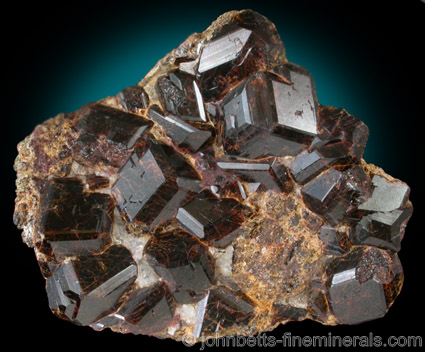The Mineral andradite

Andradite is a member of the Garnet group, and although not as well-known as other Garnets such as Almandine or Pyrope, it is still fairly abundant and can produce fine Garnet gemstones. A valuable gem form of Andradite is the rare Demantoid, which is a transparent green variety that is highly lustrous with an adamantine luster. Andradite is named in honor of José Bonifácio de Andrada e Silva (1763-1838), a Brazilian mineralogist, statesman, professor, and poet, famous for his discovery of Andradite as well as several other important minerals such as Spodumene.
Chemical Formula
Ca3Fe3+2Si3O12
Color
Brown, reddish-brown, bronze, orange, yellow, green, brownish-green, gray, and black. Occasionally iridescent and multicolored with streaks of brownish yellow, reddish-brown, and black.
Crystal Habits
Most often as dodecahedral crystals and intergrown dodecahedral crystal groups. Occasionally trapezohedral, and sometimes in complex combinations of dodecahedral and trapezohedral crystals. Also occurs grainy, massive, and in dense spiky crystal agglomerates and balls.
Additional Information
Composition
Calcium iron silicate, sometimes with some aluminum, chromium, or titanium replacing some iron |
In Group
Silicates; Nesosilicates; Garnet Group |
Striking Features
Crystal forms, color, hardness, and luster |
Environment
In contact metamorphic rocks in hornfels, metamorphosed limestones, and Serpentine deposits; also in igneous rock in basalt and in granite pegmatites; and in sedimentary placer deposits.
|
Rock Type
Igneous, Sedimentary, Metamorphic |
Varieties
-
Garnet from the African country of Mali that ranges from green to yellow to brown (though most often a
greenish-yellow). The deposit of these
Garnets was discovered in Mali in 1994, and their scientific classification is not clearly identified; they can be either Grossular or
Andradite depending on their chemical composition. X-ray analysis has determined most of these Garnets to be an intermediary form of the Grossular / Andradite series, though closer in chemical structure to
Grossular. Although this is a relatively new term, it has become extensively used in the gem trade.
-
Rare form of Garnet that is sometimes classified as a titanium-rich variety of Andradite. However, Schorlomite is scientifically classified as a individual mineral species.
Uses
Andradite can be very lustrous, more so than the other Garnet forms, and makes good gemstones despite it being slightly lacking in hardness. The yellow, orange, brown, and black varieties can all faceted as Garnet jewelry, but the Demantoid variety is the main gem form of Andradite (as well as one of the most valuable forms of Garnet).
Also see the gemstone section on Andradite and Garnet.
Andradite specimens, especially those in well-crystallized forms, can be highly sought after by mineral collectors.
Noteworthy Localities
Though Andradite is a less common form of Garnet, there are many fine localities for this mineral. The most historical and well-known occurrence of the Demantoid variety is the Val Malenco, Sondrio, Italy. Another Italian Demantoid locality is the Val D'Ala. Good single crystals of Demantoid come from the Ural Mountains of Russia, especially at Korkodinskoe. A toothpaste-green Demantoid was recently discovered in Ghazni Province, Afghanistan; and deep emerald-green Demantoid from Soghan, Kerman Province, Iran. Two important African Demantoid occurences are Antetezambato, near Ambanja, Antsiranana Province, Madagascar; and Karibib, Erongo Region, Namibia (at the Tubussis 22 Farm and Usakos).
Andradite of all colors comes from the famous occurences of Dal'negorsk,
Primorskiy Kraj, Russia (especially at the Sinerechenskoye skarn occurrence). A dark greenish-brown Andradite comes from Marki Khel, Nangarhar Province, Afghanistan; and excellent dark lustrous crystals from Dashkesan, Azerbaijan. Good crystals, including an iridescent type, were found in the Kohse mine, Tenkawa, Japan.
Very good Topazolite comes from Condove, Val D'Susa, Italy; and Melanite from San Vito, Monte Somma, Vesuvius, Italy. A rusty-brown Andradite comes from Mega Xhorio, Serifos Island, Greece; and sugary-textured crystals from Monforte, Portalegre District, Portugal. Very large brown and black Andradite crystals come from the Kayes Region, Mali, especially at Trantimou. An exceptional pink and red variety comes from the Kalahari manganese fields in South Africa, most notably in the Wessels Mine (Hotazel) and in the N'Chwaning Mines.
In Canada, a rich emerald-green Demantoid in amphibole came from a find in the Jefferey Mine in Asbestos, Québec. Also in Quebec is the famous Mont St. Hilaire deposit; and the Thetford Mines (and nearby Black Lake), which produce fine Andradite including deep green Demantoid. Lustrous black Melanite comes from the Ojos Espanoles Mine, Lázaro Cárdenas, Chihuahua, Mexico.
In the U.S,. a famous Andradite locality of brownish-green crystals and bronze Topazolite in dense crystal groupings is Stanley Butte (and Quartzite Mountain), in the San Carlos Indian Reservation, Graham Co., Arizona. Very large Andradite crystals come from Garnet Hill, Calaveras Co., California; and excellent lustrous black Melanite and Topazolite from several mines in the New Idria District in the Diablo Range, San Benito Co., California. Brownish-red crystals come from the Nightingale District, Pershing County, Nevada. Good large single crystals of Melanite come from Magnet Cove, Hot Spring County, Arkansas; and the Cornwall Iron Mines, Lebanon Co., Pennsylvania. Andradite is abundant in Franklin and Ogdensburg, Sussex Co., New Jersey, and though mostly in massive form, good crystals have come from there as well.
Common Mineral Associations
Albite, Orthoclase, Calcite, Tremolite, Wollastonite, Serpentine, Biotite, Chlorite, Hedenbergite, Magnetite, Diopside, Epidote
Distingushing Similar Minerals
Almandine, Spessartine, and Grossular - Can be very difficult to distinguish it from these other Garnets, although locality is often a good indicator.
Uvarovite - Occurs in deeper colored green crystals and in aggregates of tiny crystals, as well as in a different environment.